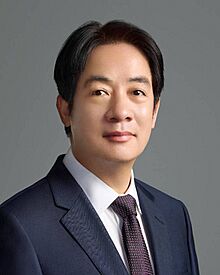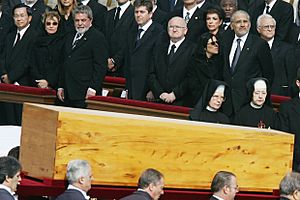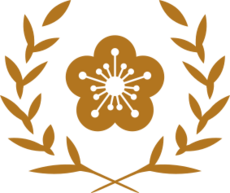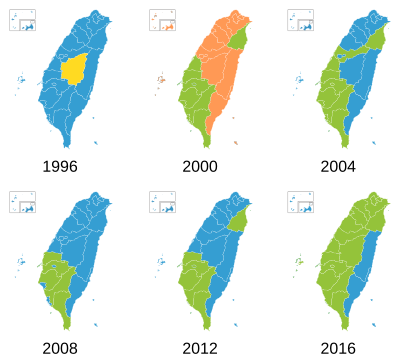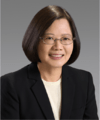President of the Republic of China facts for kids
Quick facts for kids President of the Republic of China |
|
|---|---|

Presidential standard
|
|

Presidential seal
|
|
| Office of the President | |
| Style | Mr. President (informal) His Excellency (diplomatic) |
| Member of | National Security Council |
| Residence | Wanli Residence |
| Seat | Presidential Office Building, Taipei |
| Appointer | Direct election or via succession |
| Term length | 4 years; renewable once |
| Precursor | Chairman of the National Government (1925–1948) |
| Formation | 1 January 1912 (provisional, in Mainland China) 25 October 1945 (Taiwan handover) 20 May 1948 (current form) |
| First holder | Sun Yat-sen (as Provisional President) |
| Deputy | Vice President |
| Salary | NTD 531,000 monthly (2024) |
| President of the Republic of China |
|||||||||||||||||||||||||||
|---|---|---|---|---|---|---|---|---|---|---|---|---|---|---|---|---|---|---|---|---|---|---|---|---|---|---|---|
| Traditional Chinese | 中華民國總統 | ||||||||||||||||||||||||||
| Simplified Chinese | 中华民国总统 | ||||||||||||||||||||||||||
|
|||||||||||||||||||||||||||
| President of China (until 1971) |
|||||||||||||||||||||||||||
| Traditional Chinese | 中國總統 | ||||||||||||||||||||||||||
| Simplified Chinese | 中国总统 | ||||||||||||||||||||||||||
|
|||||||||||||||||||||||||||
| President of Taiwan | |||||||||||||||||||||||||||
| Traditional Chinese | 臺灣總統 台灣總統 |
||||||||||||||||||||||||||
| Simplified Chinese | 台湾总统 | ||||||||||||||||||||||||||
|
|||||||||||||||||||||||||||
The President of the Republic of China, also known as the President of Taiwan, is the top leader of Taiwan. This person is the head of state, meaning they are the official representative of the country. They are also the commander-in-chief of Taiwan's military, the Republic of China Armed Forces.
Before 1949, this position had power over Mainland China. However, after the Chinese Civil War, the Republic of China's control became limited to Taiwan, Penghu, Kinmen, Matsu, and other smaller islands.
The president was originally chosen by the National Assembly. The job was first meant to be more ceremonial, like a figurehead, with less real power. This was because Taiwan was planned to be a parliamentary republic, where the parliament had more power.
However, since the 1996 election, the president is now directly elected by the people. They are chosen by plurality voting, which means the candidate with the most votes wins. A president serves a four-year term and can be re-elected only once. The current president is Lai Ching-te from the Democratic Progressive Party. He took office on May 20, 2024.
Contents
Who Can Be President?
The Presidential and Vice Presidential Election and Recall Act sets rules for who can become president or vice president.
- A candidate must be a citizen of the Republic of China.
- They must be at least 40 years old.
- They need to have lived in the Taiwan Area for at least 15 years.
- They must have been physically present in Taiwan for at least 6 months in a row.
Some people cannot run for president:
- People who are currently in the military.
- Officials who work on elections.
- People who have foreign citizenship or do not live in the Free Area of the Republic of China.
- People who got their citizenship back or became citizens through naturalization.
What the President Does
The president is elected for a four-year term by direct vote from the people in areas controlled by Taiwan. Before 1991, the president was chosen by the National Assembly of the Republic of China for a six-year term.
The Constitution of the Republic of China says the president is the head of state and the leader of the military. The president handles foreign relations, like making treaties, declaring war, and making peace. The president must announce all new laws. They cannot stop a law from passing, but they can approve or reject a veto suggested by the Executive Yuan (which is like the Cabinet).
Other important powers of the president include:
- Granting amnesty, pardon, or clemency (which means forgiving or reducing punishments for crimes).
- Declaring martial law (when the military takes control in an emergency).
- Giving out honors and awards.
In emergencies, the president can issue special orders and take necessary actions to protect the country or its people. This can also happen during serious money or economic problems. However, these orders must be approved by the Legislative Yuan (Taiwan's parliament) within ten days. If the Legislative Yuan does not approve, the orders become invalid.
The president can also appoint special advisors. These advisors help the president with important decisions and strategies.
The Constitution does not clearly state if the president or the premier (the head of the Executive Yuan) has more power. The Executive Yuan handles most domestic issues. However, the president leads the military and handles foreign affairs. Over time, the president's role has become more powerful.
When different political parties control the presidency and the Legislative Yuan, it can lead to discussions about how their powers work together. These issues are usually solved through talks between the parties.
How a New President Is Chosen if the Office Is Empty
The Constitution of the Republic of China explains what happens if the president's job becomes empty.
- If the vice president's job becomes empty, the president suggests new candidates within three months. The Legislative Yuan then votes for a new vice president. This new vice president finishes the rest of the original term.
- If both the president and vice president's jobs become empty, the head of the Executive Yuan (the premier) takes over the president's duties. Then, a new president and vice president are elected to finish the original terms.
It is not clear what would happen if the premier's job was also empty. It is thought that the vice premier would then act as president.
Currently, the order of succession is:
- Hsiao Bi-khim, the Vice President of the Republic of China.
- Cho Jung-tai, the President of the Executive Yuan (Premier).
- Cheng Li-chun, the Vice President of the Executive Yuan.
The presidency has changed hands three times due to succession since 1947:
- In 1949, President Chiang Kai-shek stepped aside during the Chinese Civil War. Vice President Li Zongren became acting president. Chiang later returned to office in 1950.
- In 1975, President Chiang Kai-shek passed away. Vice President Yen Chia-kan took over and finished the term.
- In 1988, President Chiang Ching-kuo passed away. Vice President Lee Teng-hui became president. He finished the term and was elected for two more terms.
Diplomatic Rules
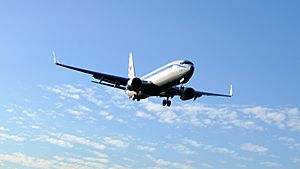
The rules for how the President of Taiwan is treated by other countries are a bit complicated. This is because of the political status of Taiwan. In countries that officially recognize Taiwan, the president is treated like any other head of state.
In other countries, the president is formally seen as a private citizen. Even then, their visits often face strong objections from the People's Republic of China.
The President of Taiwan has visited the United States several times. These visits are usually called "transit" stops on the way to countries in Central America that recognize Taiwan. This way, the US government does not have to issue a special visa for a head of state. During these trips, the president does not officially meet US government officials in their formal roles. They also do not visit Washington, D.C.. However, they do meet with US government staff, usually lower-ranking officials in informal settings.
In Southeast Asia, the President of Taiwan used to make visits in the early 1990s that were formally called private tourist trips. But these visits have become less common due to pressure from the People's Republic of China.
At the yearly Asia-Pacific Economic Cooperation (APEC) leaders' meeting, the President of Taiwan is not allowed to attend in person. Instead, they must send a special representative.
However, in December 2016, then US President-elect Donald Trump accepted a phone call from the President of Taiwan. This was a clear change from the usual diplomatic rules.
The government and media of the People's Republic of China use terms like Leader of the Taiwan Area or Leader of the Taiwanese Authorities to describe Taiwan's head of state. They do this to show that they do not recognize Taiwan as a country. If they have to use the official title in a news article, they often put quotation marks around it.
Secretary-General to the President
The secretary-general to the president is the most senior official in the Office of the President. This person manages the staff who work for the president. The current secretary-general is Pan Men-an.
Symbols of the President
The president's podium has a special symbol. It is a golden plum blossom surrounded by a laurel wreath.
The presidential standard is the official symbol of the president as the leader of the Republic of China Armed Forces. This flag is red with a thin yellow border. In the middle, it has the national emblem of the Republic of China. The standard is flown at the Presidential Office and other places the president uses. It is also used on vehicles when the president is traveling and in special ceremonies.
The Presidential Seal is a square stamp. The words on it, 總統之印, are written in a special old style called seal script. The words mean "Seal of the President."
Presidential Elections
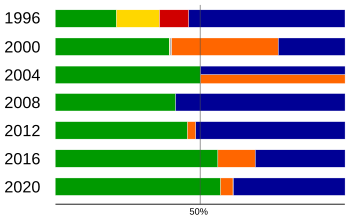
A chart comparing the vote percentages in direct presidential elections.
: Democratic Progressive Party candidates : Kuomintang candidates : People First Party candidates, or James Soong. : New Party candidates. : Taiwan People's Party candidates : Other independent candidates |
| Order | Main article | How the President was Elected |
|---|---|---|
| 1st | 1948 Chinese presidential election | Chosen by the 1st National Assembly |
| 2nd | 1954 Taiwanese presidential election | |
| 3rd | 1960 Taiwanese presidential election | |
| 4th | 1966 Taiwanese presidential election | |
| 5th | 1972 Taiwanese presidential election | Chosen by the 1st National Assembly (with some new members) |
| 6th | 1978 Taiwanese presidential election | Chosen by the 1st National Assembly (with more new members) |
| 7th | 1984 Taiwanese presidential election | Chosen by the 1st National Assembly (with even more new members) |
| 8th | 1990 Taiwanese presidential election | Chosen by the 1st National Assembly (with the newest members) |
| 9th | 1996 Taiwanese presidential election | Directly elected by the people of Taiwan |
| 10th | 2000 Taiwanese presidential election | |
| 11th | 2004 Taiwanese presidential election | |
| 12th | 2008 Taiwanese presidential election | |
| 13th | 2012 Taiwanese presidential election | |
| 14th | 2016 Taiwanese presidential election | |
| 15th | 2020 Taiwanese presidential election | |
| 16th | 2024 Taiwanese presidential election |
History of the Presidency
Taiwan was under Japanese rule from 1895 to 1945. During this time, it was led by the governor-general of Taiwan, who represented the emperor of Japan.
The Republic of China was officially started on January 1, 1912. This happened after the Wuchang Uprising against the Qing Dynasty in 1911. Revolutionaries chose Sun Yat-sen as the "provisional president" of the new government. Sun soon stepped down, and Yuan Shikai became "Great President" in March 1912. Yuan made the Last Emperor give up his throne, ending thousands of years of imperial rule in China.
The 1913 Constitution aimed for a strong president but with checks on power from the National Assembly. However, Yuan Shikai soon became a dictator and even tried to make himself Emperor of China in 1915. He had to give up this idea before he died in 1916.
After Yuan Shikai's death, China entered the Warlord Era. Different military leaders fought for control. The presidency was held by various warlords. This period ended in 1928 when the Kuomintang (KMT) party, led by the Northern Expedition, took control of North China.
Sun Yat-sen had also set up a different government in Guangzhou in 1917. He was called "Generalissimo of the Military Government." He later returned in 1921 and was elected "Extraordinary President." Sun passed away in 1925. After his death, the government, now called the National Government, was led by committees of the Kuomintang. The "Chairman of the National Government" acted as the head of state. This system lasted until a new Constitution was created in 1947.
After China won the Second Sino-Japanese War, the National Government, led by Chiang Kai-shek, returned to Nanjing. The KMT wanted to create a democratic constitution. The new Constitution of the Republic of China was announced on December 25, 1947. It created a government with five branches and made the president the head of state. On May 20, 1948, Chiang Kai-shek was officially elected as the first president by the National Assembly.
After the KMT lost mainland China in the Chinese Civil War, the government moved to Taiwan. The rules about how long a president could serve were paused after 1960. The members of the National Assembly continued in their roles until 1991. They kept electing Chiang Kai-shek as president until he passed away in 1975.
Presidents were chosen by the National Assembly until 1996. That year, the first direct presidential election was held, meaning people voted directly for their president. At this time, the president's term was also changed from six years to four years.
Timeline of Presidents

- Cen Chunxuan was the president of the southern military government of the Republic of China from 1913 to 1921.
- First Provisional President and Presidents after the 1947 Constitution
-
Sun Yat-sen
First Provisional President
(served: 1912) -
First: Chiang Kai-shek
Served 5 terms
(served: 1948–1975) -
Third: Chiang Ching-kuo
Served 6th & 7th terms
(served: 1978–1988) -
Fourth: Lee Teng-hui
Finished 7th term, then served 8th & 9th terms
(served: 1988–2000) -
Fifth: Chen Shui-bian
Served 10th & 11th terms
(served: 2000–2008) -
Sixth: Ma Ying-jeou
Served 12th & 13th terms
(served: 2008–2016) -
Seventh: Tsai Ing-wen
Served 14th & 15th terms
(served: 2016–2024) -
Eighth: Lai Ching-te
Serving 16th term
(serving: 2024–present)
Images for kids
-
The Presidential Building in Zhongzheng District, Taipei, is where the ROC president's office is located today.
-
The Presidential Southern Office in Fengshan District, Kaohsiung, opened on March 10, 2017.
-
The Presidential Central Office in Fengyuan District, Taichung, opened on March 18, 2017.
-
After Yuan Shikai's Peiyang Government took control of the ROC, this house in Peking was the office of the president.
-
The Presidential Palace in Xuanwu District, Nanjing, housed the office of the chairman of the National Government of the ROC from 1927–1937.
See also
 In Spanish: Presidente de la República de China para niños
In Spanish: Presidente de la República de China para niños
- Elections in Taiwan
- History of Taiwan
- Vice President of the Republic of China
- Premier of the Republic of China
- List of presidents of the Republic of China
- Politics of the Republic of China
- List of political parties in the Republic of China
- List of rulers of Taiwan
- Republic of China Presidential Museum


